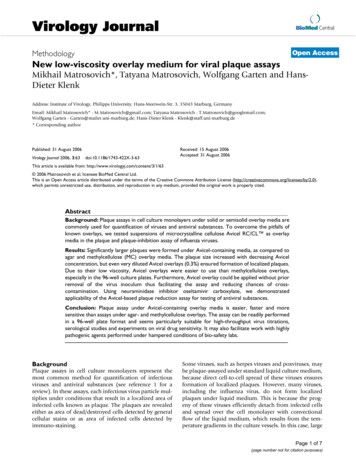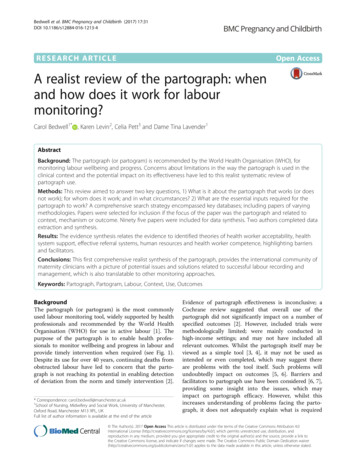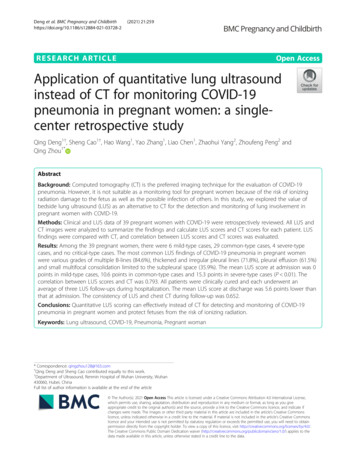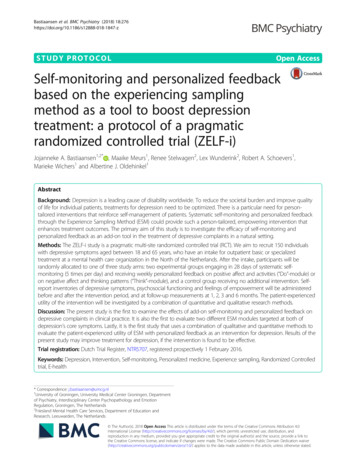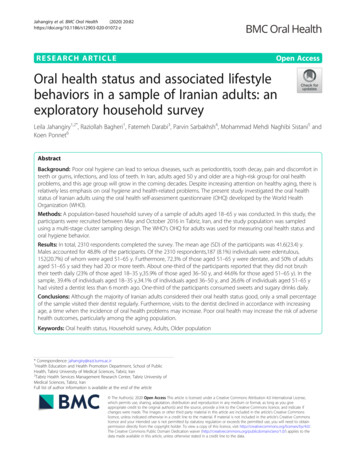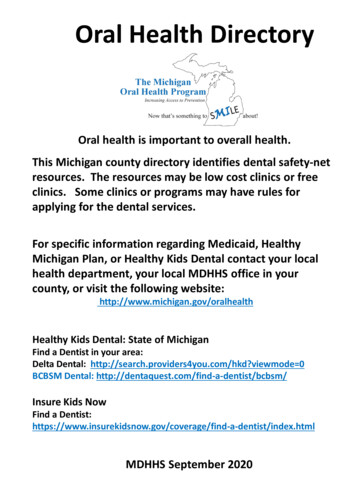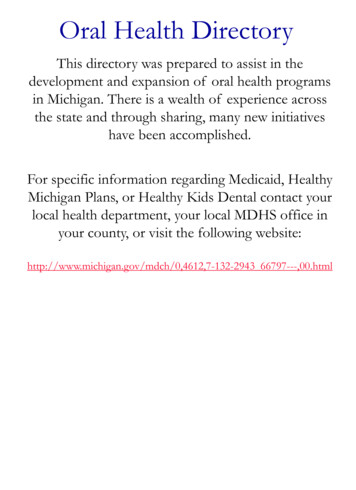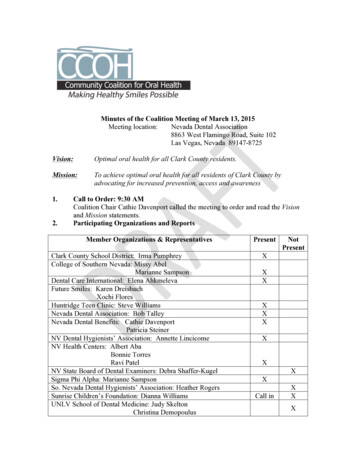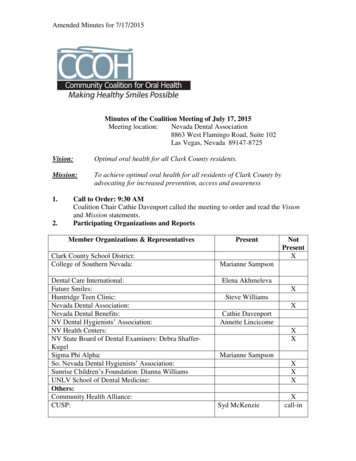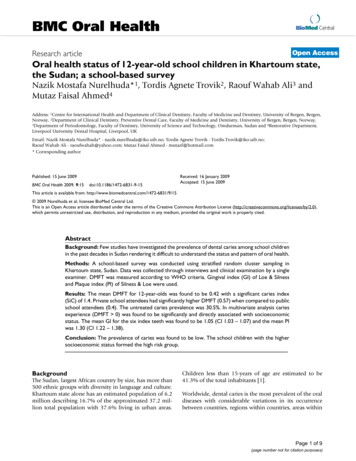
Transcription
BMC Oral HealthBioMed CentralOpen AccessResearch articleOral health status of 12-year-old school children in Khartoum state,the Sudan; a school-based surveyNazik Mostafa Nurelhuda*1, Tordis Agnete Trovik2, Raouf Wahab Ali3 andMutaz Faisal Ahmed4Address: 1Centre for International Health and Department of Clinical Dentistry, Faculty of Medicine and Dentistry, University of Bergen, Bergen,Norway, 2Department of Clinical Dentistry, Preventive Dental Care, Faculty of Medicine and Dentistry, University of Bergen, Bergen, Norway,3Department of Periodontology, Faculty of Dentistry, University of Science and Technology, Omdurman, Sudan and 4Restorative Department,Liverpool University Dental Hospital, Liverpool, UKEmail: Nazik Mostafa Nurelhuda* - nazik.nurelhuda@iko.uib.no; Tordis Agnete Trovik - Tordis.Trovik@iko.uib.no;Raouf Wahab Ali - raoufwahab@yahoo.com; Mutaz Faisal Ahmed - mutazf@hotmail.com* Corresponding authorPublished: 15 June 2009BMC Oral Health 2009, 9:15doi:10.1186/1472-6831-9-15Received: 16 January 2009Accepted: 15 June 2009This article is available from: http://www.biomedcentral.com/1472-6831/9/15 2009 Nurelhuda et al; licensee BioMed Central Ltd.This is an Open Access article distributed under the terms of the Creative Commons Attribution License (http://creativecommons.org/licenses/by/2.0),which permits unrestricted use, distribution, and reproduction in any medium, provided the original work is properly cited.AbstractBackground: Few studies have investigated the prevalence of dental caries among school childrenin the past decades in Sudan rendering it difficult to understand the status and pattern of oral health.Methods: A school-based survey was conducted using stratified random cluster sampling inKhartoum state, Sudan. Data was collected through interviews and clinical examination by a singleexaminer. DMFT was measured according to WHO criteria. Gingival index (GI) of Loe & Silnessand Plaque index (PI) of Silness & Loe were used.Results: The mean DMFT for 12-year-olds was found to be 0.42 with a significant caries index(SiC) of 1.4. Private school attendees had significantly higher DMFT (0.57) when compared to publicschool attendees (0.4). The untreated caries prevalence was 30.5%. In multivariate analysis cariesexperience (DMFT 0) was found to be significantly and directly associated with socioeconomicstatus. The mean GI for the six index teeth was found to be 1.05 (CI 1.03 – 1.07) and the mean PIwas 1.30 (CI 1.22 – 1.38).Conclusion: The prevalence of caries was found to be low. The school children with the highersocioeconomic status formed the high risk group.BackgroundThe Sudan, largest African country by size, has more than500 ethnic groups with diversity in language and culture.Khartoum state alone has an estimated population of 6.2million describing 16.7% of the approximated 37.2 million total population with 37.6% living in urban areas.Children less than 15-years of age are estimated to be41.3% of the total inhabitants [1].Worldwide, dental caries is the most prevalent of the oraldiseases with considerable variations in its occurrencebetween countries, regions within countries, areas withinPage 1 of 9(page number not for citation purposes)
BMC Oral Health 2009, ions and within social and ethnic groups [2]. A fewstudies investigated the prevalence of dental caries in theSudan in the past two decades. In 1986, DMFT valueswere found to be 2.9, 3.2 and 2.3 in 12-year-old urbanand rural and 11-year-old semi urban children, respectively [3]. Two years later, another study found that theDMFT rose to 3.2 in the total sample examined [4]. In1993, Raadal et al. found the mean dmft to be 1.68 in thepreschool group and 2.77 in the school group. However,the mean DMFS was 2.08 in the preschool and 3.78 in theschool group [5]. All the above investigations were conducted in Khartoum city. Through this study we intend toupdate the accumulating data worldwide in keeping withthe international trend on the index age group of 12-yearolds.Education in the SudanEducation in public schools is officially funded by thegovernment. Schools are concentrated in urban areaswhere Arabic is the medium of instruction in all publicschools and most private schools. The estimated primaryschool enrolment in Sudan was 54% of the eligible pupilsin 2007 [6]. Enrolment varies widely with as high as 78%in Khartoum city. The majority of the primary school children in Khartoum city attend public schools (88%) whilethe remaining (12%) attend private schools as of the census of 2006 [7]. This distribution justified the assumptionthat most 12-year-old children in Khartoum state could befound in schools.The aims of this paper were to assess the general oralhealth status of the 12-year-old school children in Khartoum state and to determine risk indicators associatedwith poor oral health status.MethodsSampling methodA school-based survey was conducted in Khartoum statewhich is divided into 7 main localities (Khartoum, JabalAwliya, Omdurman, Ombada, Karary, Bahry and Sharq Elnil)Figure 1. A two-stage probability proportional to size cluster sampling technique was used [8], taking into consideration school sector (private and public), the schooldensity and the distribution of girls and boys in eachlocality. The sample size was calculated by applying anestimated dental caries prevalence of 50%, a design effectof 2, and a precision of 0.06. The minimum sample sizeto satisfy these requirements was estimated to be 550 children in each school sector with dropouts taken intoaccount.Thus, 37 schools were selected at random from listsobtained from the Ministry of Education in Khartoum.These were 8 public boys' schools, 8 public girls' schools,5 public mixed gender schools, 8 private boys' schoolsand 8 private girls' schools. The children were randomlyFigure 1 of Khartoum state, Republic of the SudanLocalitiesLocalities of Khartoum state, Republic of the Sudan.1: Khartoum 2: Ombada, 3: Omdurman, 4: Karary, 5: Bahri,6: Sharq Elnil, 7: Jabal Awliya.selected from each class. The desired number of childrenwas not always found complete in the randomly selectedschools. On that account, more schools were chosen withthe geographical proximity being the criteria of selection.A total of 58 schools were eventually visited. Only one ofthe randomly selected schools was located in a site previously reported to have a water source with high fluoridecontent.The sample included healthy (present in school and freefrom any serious illness) 12-year-old school children whohad not experienced multiple extractions (more than 5missing teeth). The child's age was confirmed from theschool registries; otherwise self-reported. School childrenwere selected randomly from any of the classes, rangingfrom grade 2 in remote public schools to grade 8 in privateschools in the city centre.The final sample comprised 1,109 school children; 49.9%boys (n 553) and 50.1% girls (n 556). This samplecomprised two statistically comparable groups (public/Page 2 of 9(page number not for citation purposes)
BMC Oral Health 2009, 9:15private proportion was approximately 1:1) of school children attending public (n 557) and private schools (n 552). The simple joint result of these groups is referred toas the "total" sample in the forthcoming results. Furthermore, to report results that may represent the 12-year-oldschool children population in Khartoum state, the aforementioned groups were weighted according to their distribution in the area (public/private proportion was approximately 7:1). These results are reported under the"representative" group.Data collectionThis survey was conducted from October 2007 to February 2008. Calibration exercises were carried out at the University of Bergen. The questionnaires were constructed inEnglish translated to Arabic and back translated for validation. A pilot study was carried out. Consequently, implemented changes included a shift from self-administered toa face-to-face interview of the children in a classroom setting. When the child was unable to report on parents' education level, a letter was given to the child to be completedby their parents and returned to the author (NMN) to thiseffect.All the children were clinically examined by the mainresearcher (NMN) accompanied by a trained assistantwho recorded the data on a standardized form. The examination was carried out under natural sunlight using a disposable plane mirror and dental explorer. The later wasused to assess the plaque accumulation on the buccaltooth surface. The child was made to lie down on his backon a table or a bench and the examiner at its head. Onlycompletely erupted permanent teeth were included. Thechildren were given oral hygiene instructions followingthe examination and rewarded with a toothpaste tube.Children who needed treatment were referred to the closest dental care facility.MeasurementsClinical measuresThe clinical oral health status was measured using thedecayed, missing and filled tooth index (DMFT) according to the WHO caries diagnostic criteria for epidemiological studies [9]. A tooth was marked as 'decayed' when anyof the following was observed: unmistakable cavitationson the occlusal, buccal or lingual walls of the tooth, adetectable softened floor or wall or remaining, cariousroots and filled tooth with signs of caries. When in doubt,the tooth was recorded as sound. A tooth extracted due tocaries was marked 'missing'. Significant caries index SiCwas calculated as the mean DMFT of the one third of thestudy group with the highest caries score [10]. The careindex was defined as the fraction of filled teeth (FT) toDMFT e gingival index (GI) of Loe and Silness (1963) [12] andthe plaque index (PI) of Silness and Loe (1964) [13] wereused. GI and PI were scored based on a 0–3 scale thatcombines an assessment of tissue colour and form withbleeding on stimulation assessment and presence ofplaque, where 0 represented healthy gingiva and plaquefree tooth surface respectively. Buccal surfaces of all thepresent teeth were examined. When in doubt betweenscoring 0 or 1, the score 1 was given. Dean's index wasused to record the prevalence of dental fluorosis [14].Results are reported as either sound (score 0) or fluorosed(scores 1–4: mild to severe).Sociodemographic characteristicsThe survey comprised questions on dichotomous indicators of socioeconomic status (SES) such as parental education. Father's and mother's education were organised into'lower group' – no formal education, 'middle group' – parents who attended primary and secondary schools and'higher group' – university and beyond education. Father'seducation was furthermore dichotomized for Poissonregression analysis into lower (lower and middle groups)and higher (higher group). Localities were grouped intotwo, according to their proximity to the capital city; urban-Khartoum, Bahri and Omdurman and rural- JabalAwliya, Sharq Elnil, Ombada and Karary Table 1.The questionnaire included variables describing oralhygiene habits and attitudes such as perceived oral healthand satisfaction with oral health status on 4 points Likertscales, ranging from 'very good' and 'good' (interpreted asgood) to 'bad' and 'very bad' (interpreted as bad) and 'verysatisfied' and 'satisfied' (interpreted as satisfied) to 'notsatisfied' and 'not satisfied at all' (interpreted as not satisfied), respectively. Tooth brushing habits were reportedwith respect to frequency; regular (everyday once or more,once every second day, once every third day, once a week)and irregular. Also reported were the tools used for brushing (tooth brush, miswak, finger), agents used with brushing (tooth paste, water, other). Dental history wasrecorded based on history of visit to the dental clinic(have you visited a dental clinic before), reason for dentistvisit (follow-up, pain, other), dental floss use (yes, no)and reason behind not using the dental floss (never heardof flossing, no access to dental floss, do not feel it isimportant, do not know how to use it, other). Dentaltreatment experience was dichotomised into 'extraction'(simple treatment) and others (filling, fissure sealant,orthodontic treatment, space maintainer, other). Theyreported toothache management as 'professional' whenchildren sought care for toothache at a dental health carefacility, hospital or private clinic and 'home management'when the child handled the toothache at home by traditional methods.Page 3 of 9(page number not for citation purposes)
BMC Oral Health 2009, le 1: Frequency distribution (%, n) according to sociodemographic characteristics and dental treatment availability among schoolchildren in Khartoum state, the SudanSociodemographic characteristicsFather's educationLowMediumHighMother's educationLowMediumHighLocalityUrbanSocioeconomic status variableMiddleHistory of dentist visitFollow-up & checkupPainNever visitedDental treatment experienceExtraction onlyOthersSeek professional therapy for toothachePublic schools%(n)Private schools %(n)Total sample %(n)Representativesample % *PValue #19.9 (111)52.2 (291)26.9 (150)4.2 (23)28.6 (158)66.7 (368)12.0 (134)40.3 (449)46.5 (518)18.149.431.7.00023.3 (130)62.5 (348)13.6 (76)3.6 (20)54.7 (302)40.6 (224)13.5 (150)58.3 (650)26.9 (300)21.061.616.9.00028.4 (158)64.9 (358)46.5 (516)32.8.00021.2 (118)50.2 (277)35.4 (395)24.6.0001.1 (6)32.3 (180)66.6 (371)3.3 (18)60.0 (331)36.8 (203)2.2 (24)45.8 (511)51.5 (574)1.335.663.1.00018.3 (102)5.6 (31)18.0 (100)32.6 (180)11.4 (63)38.6 (213)25.3 (282)8.4 (94)28.1 (313)20.06.320.4.000.000* 'Total sample' (n 1109) includes all the school children who participated in the study while the 'representative sample' (n 1109) refers to theresults after weighting according to the school children distribution between the two school sectors (Public: Private 7:1)# P value for Chi-Square test to compare proportions of sociodemographic characteristics between school sectors, public and privateStatistical analysesAnalyses was done using STATA version 10 to adjust forcluster sampling, marking the strata as the locality and thesampling unit as the school and the unit of analysis beingthe schoolchild. Multivariate analysis was performedusing Poisson regression reporting prevalence ratio.Principal component analysisTo construct a good subset of SES predictors, householdlevel information on assets and education level were combined. Other indicators were ownership to the house(65%), ownership of household durable assets such asrefrigerator (77%), television receiver (90%) and car(52%); materials of the dwelling structure (cement andred brick 76%), family size (more than 3 children 49%)and house size (more than one room 91%). A principalcomponent analysis was used to define these weights. Theindex used was the first principal component (eigenvalue3.6). It summarized the largest amount of informationcommon to the variables; 35.7% of the variability in the10 variables loading on ownership of a refrigerator (0.89),house lighting (0.84), quality house building materials(0.81), combined parental education (0.69) and ownership of television (0.64). SES was assessed by dividing theprincipal component into quintiles such that each household was classified as lowest, lower, low, middle andhigher SES. For the sake of providing a dichotomised variable, the latter two were combined to predict 'middle' SESand the earlier three for 'low' SES [15].Ethical approvalWritten permission to conduct the study was obtainedfrom the Ministry of Health and Ministry of Education inKhartoum, the local administration authorities and fromthe school authorities on behalf of the children. Procedures for obtaining consent and ensuring confidentialitywere approved by the ethical research committee in theSudan.ResultsTest-retest reliabilityThe questionnaire was reintroduced to a sample of 20 randomly selected 12-year-old school children. The test-retesttime was 10 days. Kappa values for test-retest of the questionnaire ranged from 0.55 (knowledge) to 0.97 (wealthindex). The Kappa value for DMFT was 0.83 for 45 reexamined children with a 14 day interval. These values arein the interval from moderate to substantial agreementaccording to Landis and Koch [16].Sociodemographic characteristicsThe response rate was 99%. Most 12-year-old childrenattended 6th grade in public schools (49%) (range 2–8),and 7th grade in private schools (76%) (range 5–8). Fourchildren (0.4%) reported 'no tooth-brushing', 64%reported brushing their teeth at least once a day, 25%twice a day and 5% more than twice a day. Two percentused 'miswak' (natural toothbrush made from the twigs ofthe Salvadora persica tree) [17] and 97% reported usingPage 4 of 9(page number not for citation purposes)
BMC Oral Health 2009, er and toothpaste. Three percent reported using dentalfloss and 90% never heard of the dental floss before. Fiftytwo percent never visited a dentist.It was found that public schools had a significantly higherproportion of students with no caries experience (DMFT 0) (76.5% vs. 69.7%). Table 1 shows the percentage distribution of the children's sociodemographic characteristics in public and private schools. The proportion ofchildren having fathers and mothers with high educationwas found to be significantly higher among private schoolattendees compared to children attending public schools:66.7% vs. 26.9% and 40.6% vs. 13.6% respectively. Publicschool attendees reported 'good perception' and 'satisfaction' with oral health more than private school attendees(78.5% vs. 73% and 75% vs. 65%, respectively).Clinical measuresTable 2 summarizes oral health status in terms of thenumber of permanent teeth, dental caries experience(DMFT 0) and dental hygiene status (GI, PI). The meanDMFT (representative) among all 12-year-old school children was found to be 0.42 (SD 0.92); 0.40 (SD 0.92) and0.57 (SD 1.19) among public and private school attendees, respectively. The representative decayed component(DT) of the DMFT was 0.38 (90.6%), of which 82.6%affected the first permanent molars. The representativemissing teeth component (MT) was 0.03 (6.1% of DMFT)of which 74.0% affected first permanent molars. The representative filled component (FT) was 0.01. The DT, MTand FT contributed 90.2%, 7.3% and 2.5% to the DMFTin Public school attendees, compared to 86.0%, 5.3% and8.7% respectively to the DMFT in private school attendees. Furthermore, the SiC was 1.4 for the adjusted sampleand 1.6 and 1.4 for private and public school attendeesrespectively. The untreated dental caries prevalence was30.5%. The highest DMFT was reported among girlsattending private schools of Khartoum locality, 1.0 (CI0.65 – 1.3), whereas the lowest was reported among theboys attending public school in Ombada locality, 0.18(CI 0.05 – 0.32).The mean representative GI for the six index teeth (16, 12,24, 36, 32, 44) was found to be 1.05 (CI 1.03 – 1.07) andthe mean representative PI was 1.30 (CI 1.22 – 1.38). Children diagnosed with fluorosis were 11.9% of the examined sample.There was no significant difference between gendersregarding the clinically examined oral health parameters.Multivariate analysisThe Poisson regression model predicting caries experiencefrom ten independent variables was statistically significant p 0.001, chi square 52.73, Nagelkerke R2 0.015and showed significant association with higher SES. Table3 shows results from each of the unadjusted (for clustersampling) bivariate analysis and Poisson regression analysis after adjusting for the cluster effects from the differentlocalities. This test is a preferable alternative to logisticregression for the analysis of cross-sectional studies withbinary outcomes and is able to report prevalence ratios.[18].DiscussionThis study reported results that can be generalize
'higher group' – university and beyond education. Father's education was furthermore dichotomized for Poisson regression analysis into lower (lower and middle groups) and higher (higher group). Localities were grouped into two, according to their proximity to the capital
